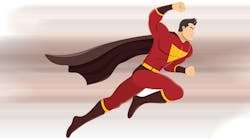One of my favorite TV shows is "South Park." While it's raunchy and constantly borders on crossing the line, it's great social commentary in some cases.
One particular episode I've seen about a dozen times features a superhero named Captain Hindsight. This fictional character sticks in my mind because the message or symbolism of him rings true when it comes to regretting a situation and having to deal with consequences that could have been avoided with some prior analysis or foresight.
Captain Hindsight's escapades date back to 2010 and the Deepwater Horizon oil spill. The "South Park" fan wiki describes him best as "a superhero who ‘helps' people in need by appearing at the scene to lecture them about what they did wrong to get into a certain accident and what methods they could have used to avoid it, instead of actually rescuing them."
It's humorous when he offers his two cents, almost immediately after something has gone awry, such as in one scene, a building fire.
Fireman: There's people trapped in that burning building, Captain Hindsight. And the fire is so massive we can't get to them.
Captain Hindsight: Hmmm... You see those windows on the right side? They should have built fire escapes on those windows for the higher floors, then people could have gotten down. And then on the roof: they should have built it with a more reinforced structure, so a helicopter could have landed on it.
Fireman: Yes, of course.
Captain Hindsight: And then you see that building to the left?
Fire Captain: Yes.
Captain Hindsight: They shouldn't have built that there. Because now you can't park any fire trucks where you really need to. [stands up tall] Well, looks like my job here is done. Goodbye everyone! [takes off]
Fireman: Thank you, Captain Hindsight!
He has a penchant for pointing out the obvious and stating what should have, could have or would have been done to prevent the incident.
"Do you have any idea what a curse it is to have perfect 20/20 hindsight?" Captain Hindsight says. "As soon as something bad happens, I immediately know how it could have been avoided. I can't take it anymore!"
As EHS professionals, hindsight is not a superpower, not something at which to laugh and it's most certainly something we don't want to use at any point. Just like Captain Hindsight, after an accident occurs, an investigation will show the root cause, leading you to say how it should have, could have or would have been prevented.
What does it mean when a company or EHS professional needs to use hindsight? It means there was an oversight in the safety process that should have been identified before the incident happened, and the consequences could be far-reaching.
This is why it is imperative to monitor job sites and evolve your safety plans and procedures – whether you're shifting locations, adding new equipment or hiring additional workers.
Simply waiting until something happens to say, "we should have had training on this," or "we could have avoided this if we did something this way," makes your company sound like it doesn't nurture a positive safety culture and doesn't care about its employees.
In "South Park," characters applaud Captain Hindsight after he spews a string of scenarios in which the situation would not have occurred. He responds with "It's not a blessing, it's a curse." While it's comical in the show, it's no laughing matter when you relate this to workplace health and safety. It's not useful to see hazards or risks after an accident already has happened.
We all have hindsight. It's easy to point out what should have, could have or would have been had we not taken those extra steps to ensure worker safety. This is why company leaders and EHS professionals need to play the part of safety superheroes and take responsibility for worker wellbeing.
Even though, in some cases, it's hard to substantiate to workers the need or value of safety training or the reasons why some job tasks are performed a certain way, failure to do so could lead to an accident and, eventually, having to use hindsight. And that's no way to save the day.
